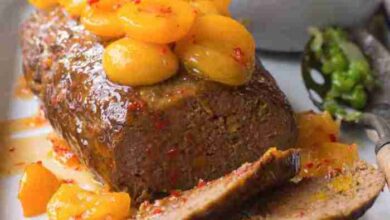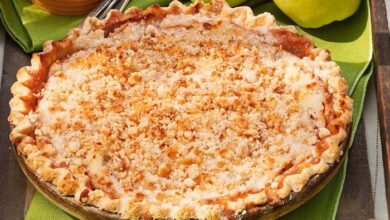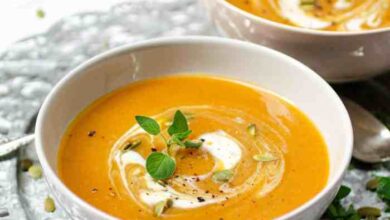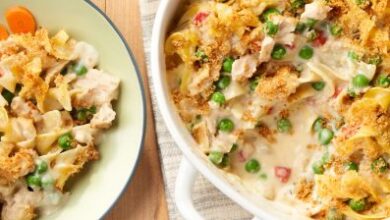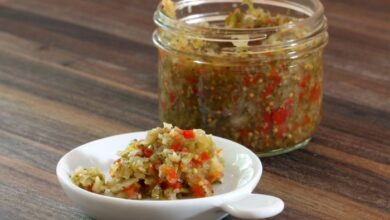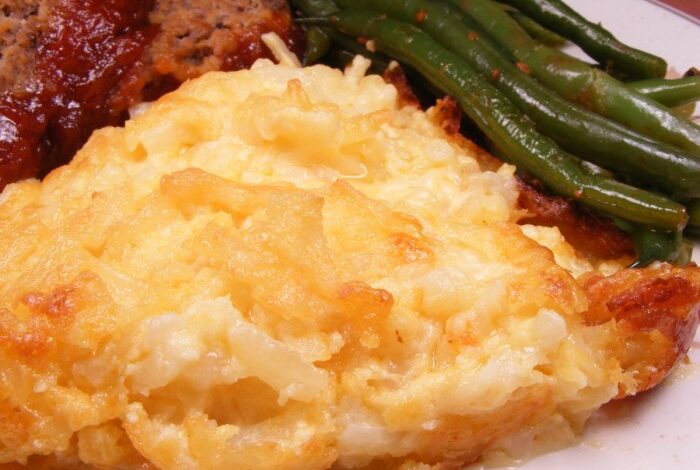
Restaurant Style Hashbrown Casserole: A Comfort Food Classic
Restaurant style hashbrown casserole is a dish that evokes memories of cozy mornings, hearty brunches, and comforting dinners. This iconic casserole, a staple in many restaurants across the country, is a testament to the power of simple, yet delicious, ingredients combined with a touch of culinary magic.
From its humble origins to its present-day popularity, hashbrown casserole has captured the hearts and stomachs of food lovers everywhere.
The magic of this dish lies in its versatility. It can be enjoyed as a breakfast treat, a satisfying lunch option, or a comforting dinner side. The crispy, golden-brown crust, the creamy, cheesy interior, and the perfect balance of flavors make it a dish that can be enjoyed by people of all ages.
The History and Origins of Restaurant-Style Hashbrown Casserole
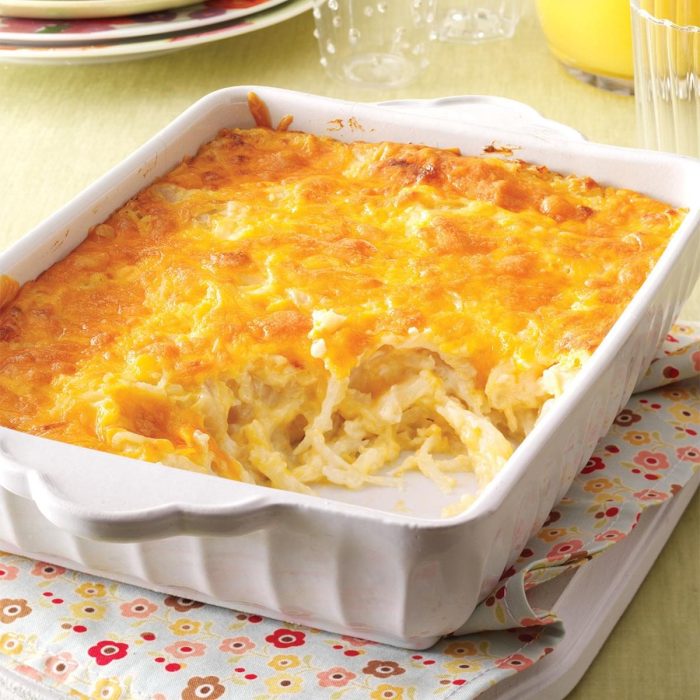
The origins of hashbrown casserole are intertwined with the history of both hash browns and casseroles, two beloved American culinary staples. While the exact origins of hashbrown casserole are unknown, its evolution can be traced through the development of its individual components.
Hash browns, a dish consisting of grated potatoes fried until crispy, emerged as a popular breakfast item in the early 20th century. Casseroles, on the other hand, gained prominence in American kitchens during the same period, offering a convenient and economical way to combine various ingredients into a single dish.
The marriage of these two culinary trends likely led to the creation of hashbrown casserole, a dish that combined the savory appeal of hash browns with the convenience of a casserole.
Restaurant-style hashbrown casserole is a classic comfort food that’s always a crowd-pleaser. It’s a dish that’s perfect for a casual dinner party or a cozy night in. But if you’re looking for a fun and unique twist, try adding some crispy bacon-wrapped water chestnuts, like the ones found in this recipe.
The combination of the creamy casserole and the salty, crunchy bacon-wrapped water chestnuts is a delicious and satisfying experience. You can even use the leftover water chestnuts as a topping for your casserole, adding another layer of flavor and texture.
Evolution of Hashbrown Casserole
The early versions of hashbrown casserole were likely simple preparations involving sauteed hash browns, cheese, and often some type of meat or vegetable. However, as the dish gained popularity, it evolved into a more complex and elaborate creation, often featuring a creamy sauce, additional vegetables, and a crispy topping.
I love a good restaurant-style hashbrown casserole, especially when it’s served alongside a fresh, vibrant salad. To really elevate the meal, I’ve been making this colorful kale and spinach salad with a homemade dressing – the tangy dressing cuts through the richness of the casserole perfectly.
It’s the perfect way to add a healthy and flavorful contrast to the hearty hashbrowns.
The restaurant-style version of hashbrown casserole, which we know today, is characterized by its generous use of cheese, often a combination of cheddar and Monterey Jack, a creamy sauce, and a crispy topping made with breadcrumbs or crushed potato chips.
There’s something about a restaurant-style hashbrown casserole that just hits the spot. The crispy edges, the creamy center, and the perfect balance of savory flavors are hard to resist. To add a little extra freshness to my next casserole, I’m planning to serve it alongside a side of grilled garlic parmesan zucchini.
The zucchini’s light, slightly sweet flavor will be a delicious contrast to the richness of the casserole, and the parmesan cheese will add a salty kick that complements the dish perfectly.
This version of the dish is typically served as a side dish alongside other comfort food staples like fried chicken, pork chops, or steak.
Cultural and Regional Variations
Hashbrown casserole, like many other American dishes, has evolved into a variety of regional variations. Some regions, like the South, favor a more decadent version of the dish, often incorporating ingredients like bacon, sausage, or jalapenos. In other regions, like the Midwest, a more basic version with simply hash browns, cheese, and cream is favored.
“Hashbrown casserole is a dish that is as versatile as it is delicious. It can be adapted to suit a variety of tastes and preferences, making it a true American classic.”
Key Ingredients and Their Roles
The magic of restaurant-style hashbrown casserole lies in its carefully chosen ingredients, each playing a crucial role in creating the iconic flavor and texture. From the base of crispy hash browns to the creamy cheese sauce and the finishing touches of seasonings, every element contributes to the dish’s irresistible appeal.
Hash Browns
Hash browns form the foundation of this casserole, providing a satisfyingly crispy texture and a neutral canvas for the flavors to shine. Typically, frozen shredded hash browns are used, offering convenience and consistent results. The key to achieving the perfect crisp lies in ensuring the hash browns are thoroughly thawed and drained before being incorporated into the casserole.
This prevents excess moisture from making the casserole soggy.
Cheese
Cheese plays a vital role in adding richness and creaminess to the casserole. The most common cheese choices include cheddar, Monterey Jack, and Colby, each offering a unique flavor profile.
Types of Cheese
- Cheddar: Known for its sharp, tangy flavor, cheddar adds a distinct taste to the casserole.
- Monterey Jack: This mild, slightly sweet cheese provides a creamy texture and a subtle flavor that complements the other ingredients.
- Colby: A versatile cheese with a slightly sweet and buttery flavor, Colby contributes a pleasant richness to the casserole.
Often, a combination of these cheeses is used to create a well-balanced flavor profile.
Seasonings and Spices
Seasonings and spices are essential for creating the signature flavor profile of restaurant-style hashbrown casserole.
Common Seasonings
- Salt and Pepper: These basic seasonings enhance the overall flavor and balance the richness of the cheese.
- Onion Powder and Garlic Powder: These additions provide a savory depth of flavor and enhance the overall aroma of the casserole.
- Paprika: A touch of paprika adds a subtle sweetness and a vibrant color to the dish.
Some recipes also call for other spices like cayenne pepper for a hint of heat or dried herbs like thyme or rosemary for added complexity.
Variations and Customization
The beauty of restaurant-style hashbrown casserole lies in its adaptability. It’s a blank canvas for culinary creativity, allowing you to personalize the dish with an array of ingredients and flavor combinations. This versatility makes it a crowd-pleaser, catering to diverse tastes and dietary needs.
Popular Variations
Restaurant-style hashbrown casserole is often elevated with the addition of meats, vegetables, and different types of cheese. These additions enhance the flavor profile and add textural contrast.
- Meats:Popular choices include bacon, sausage, ham, ground beef, and shredded chicken. These meats impart savory notes and richness to the casserole.
- Vegetables:Common additions include onions, peppers, mushrooms, broccoli, and spinach. These vegetables add color, texture, and nutritional value to the dish.
- Cheese:A variety of cheeses can be used, from classic cheddar to sharp white cheddar, Monterey Jack, and even crumbled blue cheese. The cheese provides a creamy, melty texture and adds a distinct flavor.
Customization Tips
- Spice it Up:For a bolder flavor, add a pinch of cayenne pepper, paprika, or chili powder to the casserole. This will give it a subtle kick.
- Go Green:Incorporate fresh herbs like chives, parsley, or dill to add a vibrant touch of flavor and aroma.
- Dietary Considerations:To cater to specific dietary needs, you can substitute ingredients like using dairy-free cheese for those with lactose intolerance or opting for gluten-free hash browns for individuals with gluten sensitivity.
- Seasonal Flavors:Embrace seasonal ingredients like summer corn, winter squash, or fresh herbs to add a touch of the current season to your casserole.
Unique Flavor Combinations
Beyond the traditional ingredients, explore unique flavor combinations to create your signature hashbrown casserole.
- Mediterranean Twist:Combine crumbled feta cheese, chopped olives, sun-dried tomatoes, and fresh oregano for a Mediterranean flair.
- Asian Fusion:Incorporate stir-fry vegetables like broccoli, carrots, and snap peas, along with soy sauce, sesame oil, and a touch of ginger for an Asian-inspired twist.
- Tex-Mex Delight:Add diced jalapenos, shredded cheddar cheese, and a dollop of sour cream for a Tex-Mex twist.
Cooking Techniques and Methods
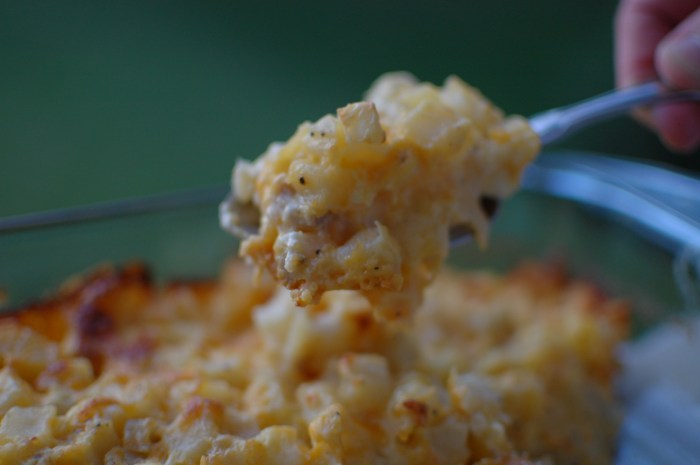
Mastering the art of preparing restaurant-style hashbrown casserole involves a series of carefully executed steps that ensure a delightful combination of textures and flavors. From the initial preparation of the potatoes to the final baking, each stage contributes to the overall success of this beloved dish.
Pre-Cooking the Potatoes
Pre-cooking the potatoes is crucial for achieving a tender and flavorful casserole. This step involves parboiling or frying the potatoes until they are partially cooked. Parboiling involves simmering the potatoes in salted water until they are slightly softened but still hold their shape.
Frying, on the other hand, involves cooking the potatoes in oil until they are golden brown and crispy on the outside. Both methods contribute to the overall texture of the casserole by ensuring that the potatoes are cooked through without becoming mushy.
Assembling the Casserole
Once the potatoes are pre-cooked, they are combined with other key ingredients to create the casserole mixture. This typically involves mixing the potatoes with cheese, butter, sour cream, and seasonings. The proportions of these ingredients can be adjusted to suit individual preferences.
For example, some recipes call for a higher proportion of cheese, while others may use a more generous amount of sour cream.
Baking the Casserole
The final step in preparing restaurant-style hashbrown casserole involves baking the assembled mixture in the oven. The casserole is typically baked in a greased baking dish until it is golden brown and bubbly. During the baking process, the cheese melts and creates a creamy, gooey texture, while the potatoes become crispy on the edges.
Achieving a Crispy Crust
A crispy crust is a hallmark of a well-prepared hashbrown casserole. To achieve this desired texture, it is important to ensure that the potatoes are properly pre-cooked and that the casserole is baked at a high enough temperature. Using a baking dish with a wide surface area can also help to promote even browning and crisping.
Maintaining a Tender, Creamy Interior
While a crispy crust is desirable, it is equally important to maintain a tender, creamy interior. This is achieved by using a combination of pre-cooked potatoes, melted cheese, and a creamy sauce. The cheese helps to bind the ingredients together and create a rich, cheesy flavor, while the creamy sauce adds moisture and tenderness.
Tips for Success, Restaurant style hashbrown casserole
- Use high-quality potatoes: Choose potatoes that are firm and have a smooth skin. Russet potatoes are a popular choice for hashbrown casserole, as they have a high starch content that contributes to a crispy crust.
- Grate the potatoes evenly: Ensure that the potatoes are grated into uniform pieces for consistent cooking.
- Don’t overcook the potatoes: Overcooked potatoes will become mushy and will not hold their shape in the casserole.
- Preheat the oven: Preheating the oven ensures that the casserole cooks evenly and develops a crispy crust.
- Bake until golden brown: The casserole should be baked until the top is golden brown and bubbly.
Serving and Presentation
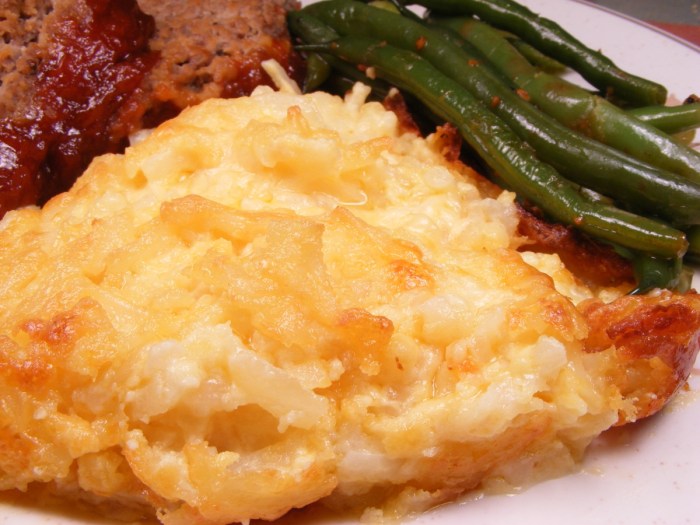
Restaurant-style hashbrown casserole is a versatile dish that can be served in a variety of ways, depending on the occasion and the desired ambiance. From casual breakfast gatherings to elegant brunch events, this hearty casserole can be presented in ways that enhance its appeal and elevate the dining experience.
Traditional Serving Methods
The most common way to serve hashbrown casserole is in a large baking dish, allowing for easy portioning and sharing. This method is perfect for family meals, potlucks, or buffet-style gatherings. The casserole can also be individually portioned into ramekins or oven-safe bowls for a more refined presentation.
Accompaniments and Side Dishes
Hashbrown casserole pairs well with a variety of accompaniments, offering a balanced and satisfying meal. Classic pairings include:
- Breakfast Sausages:A hearty and savory addition, breakfast sausages provide a contrasting texture and flavor profile.
- Bacon:Crispy bacon adds a salty and smoky element, complementing the creamy casserole.
- Eggs:Scrambled, fried, or poached eggs provide a protein boost and a touch of elegance.
- Pancakes or Waffles:A sweet and fluffy complement to the savory casserole, pancakes or waffles offer a contrasting texture and flavor.
- Fruit Salad:A refreshing and colorful addition, fruit salad adds a touch of sweetness and acidity.
Visually Appealing Presentation
Presentation plays a crucial role in creating a memorable dining experience. Here are some tips for enhancing the visual appeal of hashbrown casserole:
- Garnish with Fresh Herbs:Sprinkling chopped chives, parsley, or rosemary adds a touch of freshness and visual interest.
- Drizzle with Melted Butter:A drizzle of melted butter creates a golden sheen and enhances the flavor.
- Use a Decorative Serving Dish:A rustic wooden platter or a sleek ceramic dish can elevate the presentation.
- Serve with a Side of Sour Cream or Yogurt:A dollop of sour cream or yogurt adds a creamy contrast and a touch of elegance.
- Create a Layered Presentation:For a more sophisticated look, layer the casserole with additional ingredients like sliced tomatoes, spinach, or cheese.
Creating a Memorable Dining Experience
Hashbrown casserole can be the centerpiece of a memorable dining experience, especially when paired with the right ambiance and service. Here are some ideas:
- Set the Table with Rustic Charm:Use natural elements like wood, burlap, or mason jars to create a warm and inviting atmosphere.
- Play Up the Homey Comfort:Create a cozy and relaxed setting with soft lighting, comfortable seating, and a soundtrack of soothing music.
- Serve with a Side of Warm Hospitality:Greet guests with a smile, offer beverages, and engage in conversation to create a welcoming and memorable experience.
Nutritional Information and Health Considerations: Restaurant Style Hashbrown Casserole
Restaurant-style hashbrown casserole, while undeniably delicious, can be a bit of a nutritional rollercoaster. It’s a dish that often packs a hefty calorie count and can be high in fat, sodium, and processed ingredients. However, with some mindful adjustments, it can be enjoyed as part of a balanced diet.
Nutritional Breakdown
A typical serving of restaurant-style hashbrown casserole can contain around 400-500 calories, with approximately 20-30 grams of fat, 15-20 grams of protein, and 40-50 grams of carbohydrates. These numbers can vary significantly depending on the recipe and ingredients used. For example, a casserole loaded with cheese and bacon will naturally be higher in calories and fat than one made with leaner meats and less cheese.
Health Considerations
The high sodium content is a primary health concern with hashbrown casserole. The dish often includes processed ingredients like canned soup, frozen hash browns, and pre-shredded cheese, all of which contribute to a significant sodium intake. This can be problematic for individuals with high blood pressure or other health conditions.
Making Hashbrown Casserole Healthier
Fortunately, there are ways to make hashbrown casserole a healthier option without sacrificing taste.
- Use whole-grain ingredients:Swapping out regular potatoes for sweet potatoes or using whole-grain bread crumbs for the topping can add fiber and nutrients.
- Reduce the cheese:Using less cheese or opting for lower-fat cheese varieties can help reduce the overall calorie and fat content.
- Choose leaner meats:Using lean ground beef or turkey instead of sausage can lower the fat content.
- Use fresh ingredients:Whenever possible, use fresh ingredients like onions, peppers, and mushrooms instead of relying on processed ingredients.
- Control sodium:Check the sodium content of ingredients like canned soup and frozen hash browns and choose lower-sodium options whenever possible.

